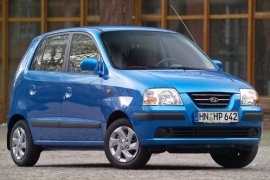
HYUNDAI Atos
Generations Timeline, Specs and Pictures

Hyundai tried to make its way into the European car market with a small MPV based on the same platform as the Kia Picanto, but the results were far below expectations.
In 1999, the Korean carmaker launched the second generation of the Atos. It looked like an ideal city car with great fuel-efficiency and small enough to sweep through the city traffic. In Europe, the customers didn’t like the car’s shape, and that resulted in slow sales, while in other markets, it was highly appreciated. In 2005, the carmaker introduced a facelifted version.
While it was still a cube on wheels with an extended front end for the engine bay, the design team managed to install a different set of headlights with a horizontal shape instead of the bubbled ones used before the facelift.
Inside, the car was spacious for four adult passengers, thanks to the high roof and high-mounted seats both front and rear. Due to that concept, the rear occupants could slide their feet under the front seats. At the front, the carmaker reshaped the dashboard and installed an open storage area on the passenger’s side. Hyundai carried over the simple design of the instrument panel from the Accent lineup.
Under the hood, the Korean carmaker installed a newly developed 1.1-liter engine and paired it to a 5-speed manual as standard. It also offered an option for a four-speed automatic transmission.

Hyundai refreshed the Atos’ second generation in 2003, after four years since the model’s introduction.
While the first generation and the non-facelifted version of the second generation showed an MPV design style, the carmaker decided to make the car looks more like a tall hatchback than a small-segment minivan.
The 2003 model came with wider, rectangular headlights and corner-mounted turn-signals. Thus, it got rid of the weird headlights from the 1999 model and introduced a redesigned grille that sported a reversed trapezoidal shape crossed by three chromed slats. But the Korean carmaker couldn’t get rid of the tall greenhouse, so it stayed the same. The rear showed a different design for the taillights, with a butterfly-like clear lens over the reversing light’s area.
Inside, the dashboard featured an open storage area in front of the passenger side. At the same time, the driver received a three-dial instrument cluster with the speedometer flanked on the sides by unusually large gauges for the coolant-temperature and fuel-level. Depending on the trim-level, the Atos offered an audio system on the center stack and an air-conditioning unit. Hyundai installed the HVAC controls below the stereo. In the back, Hyundai kept the 50/50 split-folding and tumble bench.
Since it was designed as a commuter vehicle, Hyundai installed a new 1.1-liter gasoline engine paired as standard to a five-speed manual gearbox, while a four-speed automatic was available as an option.























































